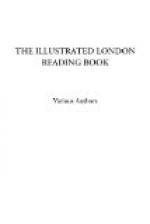[Illustration: American tapir.]
The Indian tapir greatly resembles its American relative; it feeds on vegetables, and is very partial to the sugar-cane. It is larger than the American, and the snout is longer and more like the trunk of the elephant. The most striking difference, however, between the eastern and western animal is in colour. Instead of being the uniform dusky-bay tint of the American, the Indian is strangely particoloured. The head, neck, fore-limbs, and fore-quarters are quite black; the body then becomes suddenly white or greyish-white, and so continues to about half-way over the hind-quarters, when the black again commences abruptly, spreading over the legs. The animal, in fact, looks just as if it were covered round the body with a white horse-cloth.
Though the flesh of both the Indian and American tapir is dry and disagreeable as an article of food, still the animal might be domesticated with advantage, and employed as a beast of burthen, its docility and great strength being strong recommendations.
* * * * *
THE FIELD OF WATERLOO.
Waterloo is a considerable village of Belgium, containing about 1600 inhabitants; and the Field of Waterloo, so celebrated as the scene of the battle between two of the greatest generals who ever lived, is about two miles from it. It was very far from a strong position to be chosen for this purpose, but, no doubt, was the best the country afforded. A gently rising ground, not steep enough in any part to prevent a rush of infantry at double-quick time, except in the dell on the left of the road, near the farm of La Haye Sainte; and along the crest of the hill a scrubby hedge and low bank fencing a narrow country road. This was all, except La Haye Sainte and Hougoumont. This chateau, or country-seat, one of those continental residences which unite in them something of the nature of a castle and a farm-house, was the residence of a Belgic gentleman. It stands on a little eminence near the main road leading from Brussels to Nivelles. The buildings consisted of an old tower and a chapel, and a number of offices, partly surrounded by a farm-yard. The garden was enclosed by a high and strong wall; round the garden was a wood or orchard, which was enclosed by a thick hedge, concealing the wall. The position of the place was deemed so important by the Duke of Wellington, that he took possession of the Chateau of Goumont, as it was called, on the 17th of June, and the troops were soon busily preparing for the approaching contest, by perforating the walls, making loop-holes for the fire of the musketry, and erecting scaffolding for the purpose of firing from the top.




